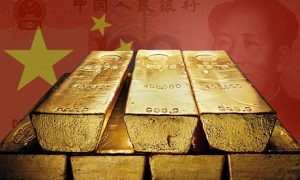Devaluation of USD Predicted as China & Russia Buy Up Gold Reserves
 Philip Klinkmüller, a financial partner with German based Hopf-Klinkmüller Capital Management has stated there is a visible trend in China and Russia to buy more bullion to end their dependency on the US dollar, and has suggested that over the next two decades global financial markets will see a significant devaluation of the US Dollar.
Philip Klinkmüller, a financial partner with German based Hopf-Klinkmüller Capital Management has stated there is a visible trend in China and Russia to buy more bullion to end their dependency on the US dollar, and has suggested that over the next two decades global financial markets will see a significant devaluation of the US Dollar.
Klinkmuller said that both China and Russia continue to stockpile gold in a bid to cut their economies’ dependency on the US dollar, and said that if the dollar’s role as a global reserve currency is decreased the world will see radical political and economic transformation. “According to our estimates, there will be a downward trend in the dollar exchange rate in the next 15 years. In the long-run, it cannot be guaranteed that the dollar will remain a global reserve currency.” Klinkmüller stated.
China is currently the world’s largest importer of gold, and is expected to keep this status in the future. China wants to use gold reserves to boost the RMB, which was added to the International Monetary Fund’s basket of reserve currencies last year. China also has a large foreign trade deficit with the US. By stockpiling bullion, Beijing wants to decrease its dependency on the US and promote the internationalization of the RMB.
Related: China’s Pan Asia Gold Exchange: A New Playing Field for Speculators?
Bullion has traditionally a major part of the Russia’s and China’s gold and foreign exchange reserves. However, nearly 60 percent of global exchange reserves are currently denominated in dollars. By stockpiling bullion, Russia and China want to get more independent in trading gold and cut their reliance on the US dollar. Gold purchases also help a country to diversify its national financial resources, as if a country purchases only one currency, it becomes dependent on the exchange rate. By purchasing gold, the central bank diversifies its resources and enhances the soundness of nation’s assets.
On Russia’s part, buying gold is helpful to offset the negative effect from sanctions, Klinkmuller said. “Russia wants to be more independent from the US dollar and act at global financial markets, using gold as a payment instrument. One of the reasons is sanctions imposed by the United States and the European Union over the Ukrainian crisis, including those in trade and investment,” he explained.
According to the World Gold Council, China and Russia are ranked sixth and seventh on the list of country with the largest gold reserves, with 1,843 tons and 1,655 tons respectively. First is the US with 8,134 tons, followed by Germany (3,380 tons) and the IMF (2,814 tons).
About Us
Silk Road Briefing is published by Asia Briefing, a subsidiary of Dezan Shira & Associates. We produce material for foreign investors throughout Eurasia, including ASEAN, China, India, Indonesia, Russia & Vietnam. For editorial matters please contact us here and for a complimentary subscription to our products, please click here.
Dezan Shira & Associates provide business intelligence, due diligence, legal, tax and advisory services throughout the Asian and Eurasian region. We maintain offices throughout China, South-East Asia, India and Russia. For assistance with OBOR issues or investments into any of the featured countries, please contact us at silkroad@dezshira.com or visit us at www.dezshira.com
Related Reading:
Silk Road and OBOR Business Intelligence
Dezan Shira & Associates´ Silk Road and OBOR investment brochure offers an introduction to the region and an overview of the services provided by the firm. It is Dezan Shira´s mission to guide investors through the Silk Road´s complex regulatory environment and assist with all aspects of establishing, maintaining and growing business operations in the region.
China’s New Economic Silk Road
This unique and currently only available study into the proposed Silk Road Economic Belt examines the institutional, financial and infrastructure projects that are currently underway and in the planning stage across the entire region. Covering over 60 countries, this book explores the regional reforms, potential problems, opportunities and longer term impact that the Silk Road will have upon Asia, Africa, the Middle East, Europe and the United States.
Financing China’s One Belt, One Road: US$8 Trillion in Capital Requirements







